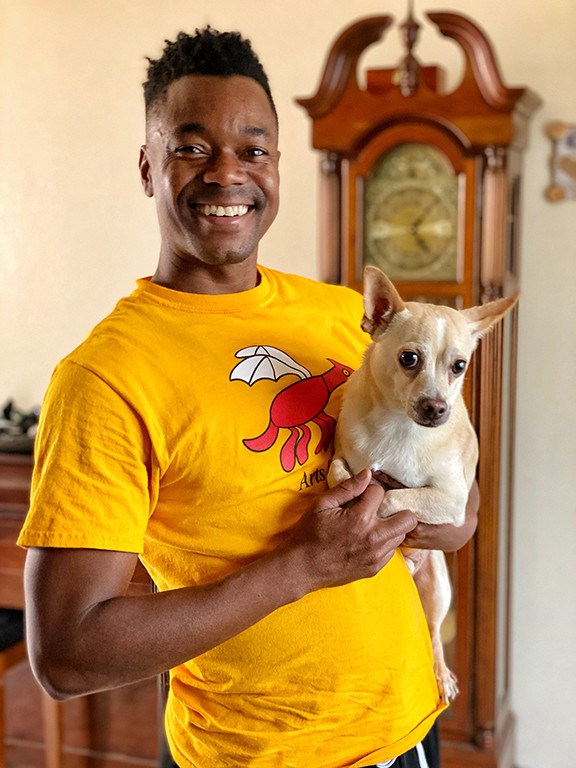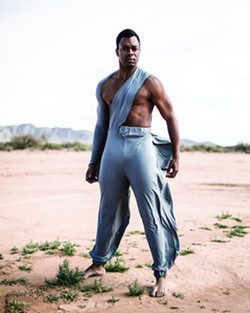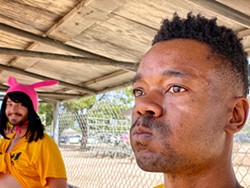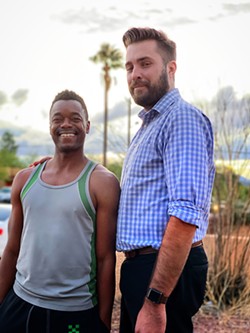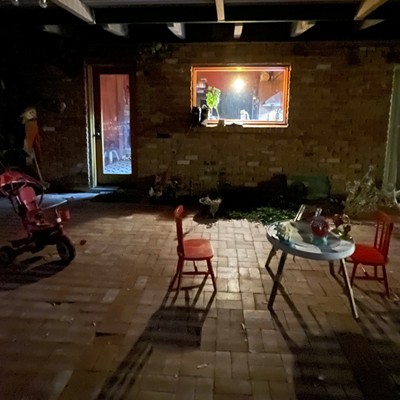Supported by gung-ho team din and Technotronic's "Pump Up the Jams," Marquez "Quezzy" Johnson saunters to the plate, grins wide, and pops a hip-hop dance move. Bases loaded, the green team pitcher backs up, deliberates a second or two and underarms a fast bouncy one toward home plate. Johnson holds the grin, strides and connects, foot-to-ball, blaam-booong! The orb soars, a bat-shit flyer beyond the reach of outfielders, and those on base sprint home. Johnson rounds the diamond in a flash of rainbow-topped tube socks and bright team yellow, his teammates in the chain-linked dugout go apeshit. Dude scores another home run.
Let's back up a second, to the kick itself. This was hardly an ordinary boot by the yellow team's MVP in Tucson's GayKickball league. Johnson showed a nutty athletic display of elegance and dancer élan—arms out-stretched, forehead slightly lifted, leg alarmingly extended. Like he floated. In slow motion. Who the hell kicks an inflated rubber ball like this? The green team hardly stands a chance.
It is a sunny Saturday morning in November at Murrieta Park's diamond playing fields, a home to games held by said kickball league. It is a colorful league too, lively and fun. Look at 20-year-old player Jacob Wilson, a white kid resplendent in a cared-for black wig, pink bunny ears, fitted gym shorts, yellow team T-shirt knotted into a halter—he can kick and scream and dance, and sing out to a boombox jam, which blares loud enough for the two side-by-side diamonds hosting games. "I figure I'll dress up, make the game a lot more fun," he says. He strikes a cheesecake pose, a study in perky contrasts to an underlying sense of competitiveness here.
The game too is loud, and can be brutal.
One ball-capped player in dark shades, who goes only by Antonio, and who outwardly appears to be an untrained athlete, is resting on the bench, watching the game unfold. "My knee is hurt," he says, "My ankle. My back. We hobble into games."
And the league? It is a growing community-based sports outfit rolling steadfast through its third year. It has two requirements to join: you must be between the ages of 20 and 80, and you must be accepting of the LGBTQ+ community. Good old inclusive Tucson boasts six 17-person teams enveloped in a multi-city national league. Each local team is assigned a color from the rainbow—pink, yellow, purple, green etc.—and feature folks from all walks and genders—lawyers, teachers, poets, students, queens, and barflies smelling of last night's gin. It is highly organized with umpires, team leaders and a 19-page rulebook. Teams play two 50-minute games per Saturday for weeks, and there is one local sponsor, Brodies Tavern, which offers players food and adult-beverages. The yellow team has lost one game this season (at press time the team lost in the local playoffs. Since Johnson is an MVP he'll travel with Tucson's best players in a greatest hits package to San Diego for the GayKickball regionals.)
The game is today's unlikely platform for the lithesome Arizona-born Johnson. The 33-year-old also happens to be a national-class dancer. And here he is right now: his back to the dugout bench, both hands pulling a muscle roller over his tender hamstring and biceps for a game in which a career-cancelling injury for any professional dancer, choreographer and teacher, is a knee crush away. A few weeks back his knees resembled hamburger meat after a game wipeout. Why?
He laughs, his shoulders lift and drop, and he says, "It's just fun. I love the competitiveness."
His entire world is based on delicate balance. Delicate because he is black and married to a white man. Delicate because this Phoenix-born kid got into the super-competitive dance program at the University of Arizona with nothing more than a fascination for hip-hop dance, a caring high-school teacher and a video tape. Delicate because his genetic gifts dovetail with a tricky-to-balance physical and emotional mindfulness. Delicate because when he moves, whether teaching or choreographing underprivileged kids or high-school students, sassy drag queens or dance greats, or starring in a production himself, there are intricacies and muscle reactions inside his movements that culminate in a grace inexpressible to another person. Even if you have little appreciation of dance, you will not forget his. Ever.
Antonio, who said only 15 minutes earlier that kickball players "hobble into games"—this guy with the nagging body parts—jumps off the bench and goddamn kicks an impressive one. There's your competitiveness.
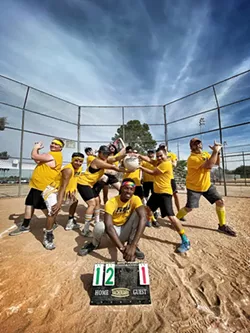
Teammates call Johnson the heart of the team, voted him most inspirational. They are in awe of his dance skills too. Team captain and stand-in coach Brian Williams, a Detroit-born active duty Air Force man in a rainbow headband, spends days as a military instructor. He says of Johnson, "He is absolutely fantastic. So he picked up [kickball] immediately. He kicks home runs. I say to him 'Can you do that again?' and he goes out and does it again.'"
And Johnson does. His kicks and the movements are who he is. There are degrees of madness to anyone who has ever done anything great and Johnson plows forward in lieu of potential injuries and consequences and it says everything about his abilities as a dancer, teacher, choreographer. It allows him to step free of his dancer bubble. After the yellow team won its two games today Johnson says he was in bed the previous night by 11. He takes kickball to heart enough to avoid his other escape, a raucous night out. "It doesn't happen that I'm in bed that early, to get that much rest—I'm good."
***
Johnson's weightiest dance performance thus far was Goliath: A Story Retold, the biblical yarn as a frighteningly beautiful headspin created by gifted choreographer, director and Artifact Dance Project co-founder Ashely Bowman. Artifact was this vital, lift-Tucson-to-a-higher-artful-plane collective that rose from a UA thesis to full-on contemporary dance/theater company in 2009. Artifact, whose focus was contemporary dance—shaped by ballet and modern dance and music—lasted a decade, and that alone is a feat.
In it, Johnson played Goliath, and hardly a giant—the relatively diminutive coryphée is no monster here, his is shifted to an empathetic overlord, an anti-hero. Bowman said her personalized dance-drama would not have happened at all without Johnson, who, through dance and movement, and a soundtrack filled of prayer-like piano ostinatos by well-established composer Zach Hemsey (whose work inspired the show), was able to convey the bigger story of turning internal anguishes inside a dying world into an outward force to help heal an immediate community. The formidable 90-minute, 10-dancer show fused ballet, contemporary and lyrical dance, some Roman and Greek mythology, and it hummed with narrative and allegory. Goliath was staged in Tucson in March this year.
That staging centered on the accumulation of Johnson's seemingly limitless gifts, that grace and internal-external communication of spirit and body, from his hip-hop roots, ballet study to mastery of dance arts, and, of course, his genetics. Johnson's performance, in a gray frock and with little external decorative display, was an embodiment of human determination. Anyway, high-horse jargon cannot articulate the emotional weight of his dance, so here it is: Often, in even the first minutes of Johnson's performance—hell, in many of his professional dance performances—people weep.
It is not easy quantizing a dancer's work, the form and integrity, balance, timing, spirit and movement, and also sexual tension—it all plays a role. In ballet the épaulement and port de bras. The staying power is in the intangibles. It is so very human but held to its highest standards.
In short, contemporary dance, a Johnson specialty, pairs the grace and precision of classical ballet alongside modern and post-modern forms (such as jazz and hip-hop). This uneasy blend works the senses, can inspire emotional or visceral responses from novice viewers and deeper meanings for those with more dance knowledge and context. Performers are dancer-choreographer hybrids, like how football great Aaron Rodgers is both player and on-field coach, able to execute tough plays (moves) while understanding their impact (contribution) onto the broader game (language of dance). Johnson satisfies because he is well-honed, mind and body, and moves in perfect sync.
"Marquez has this godlike presence of a dancer and the capacity to take on a character like this, so he was my muse the whole time," Bowman says. Johnson had been a company member in Artifact since its beginning, featured in 10 or so of its productions, "which," Bowman adds, "doesn't sound like much, but it really is." Johnson hit meltdown mode during rehearsals because the role grew into a monster that seemed impossible to pull off. Then he did it. His concerted focus to nail the thing down took on the same caterpillar-butterfly bloom of the role itself. Part of a meta directorial process Bowman perhaps knew all along.
"For Goliath," Bowman says, "I wanted him to rise up in the role and he did. As a director I knew he could do it. Marquez is authentic and lives close to his center. If you are a passionate personality like him, you can't dedicate yourself 100 percent to everything. You can't. But this guy just shows up for whatever he does; he's a mountain, a steady, stable beast of an artist. And this role was so emotionally taxing, the acting, the mind and the body."
That emotional roundelay, the depression, despair, fear, anxiety, frustration to reclamation and joy, filtered through movement, was difficult enough, but add to that the actual acting. "And," Bowman adds, "he had to keep his heartrate up! Tucson is lucky to have artists like him hanging around."
There is a driving perfectionism in immersion dance that is a form of madness, involving needs to not let anyone down, not let yourself down. As it is famously said in dance competitions, "the process is the prize." It's an internal demon no less forceful than any other crippling one, where, ultimately, you go one way or the other, depression, drugs, the bottle or discover a place of peace and maybe some grace. The demon itself is no show of failure, it is self-created fiction, but the anxiety and depression is very real.
A high-percentage of superstars in dance, likely more so than any of the arts, off themselves as tragically as their roles, often before hitting full stride, because the self-pressure is so enormous. Joseph Duell, an extraordinary choreographer offed himself by leaping out a window soon after he had attained stardom at New York City Ballet; Maria Fris, a young German ballerina, killed herself by jumping from the stage catwalk of the Hamburg Opera House during a rehearsal of "Romeo and Juliet"; American ballet star Patrick Bissell died of a heroin overdose; Maximiliano Zomosa, a pioneering dancer with the Joffrey Ballet, stabbed himself in the heart; there was Bob Fosse's speed jive. The tombstones pile up.
"I completely get it," Johnson says. "In Goliath, I didn't want to let the director down. If others thought I wasn't trying, it was just the opposite. One of the takeaways with Artifact was the roles that we were doing were really acting too, so in that way it is not who we were.
"Performance just consumes me," he continues. "Once the music starts there is a different feel with the movement, a different relationship with the music, and I connect to things in a different way than at rehearsal; it feels real, and that has nothing to do with costumes. When I get myself into that other world it makes people connect. When it has been received well you can't believe you just did that." He pauses, and adds, "It is addictive."
***
How he rolls. Forever quick to credit others in lieu of self-congratulation. He negotiates his life with a kind of bouncy mirthful obliviousness—that bubble—where his choices involve a bizarre, physically/emotionally exhausting kind of all-or-nothingness. He chooses to tackle productions, teachings, choreographies that require his all. One thing is certain: he is always on. Strangest thing: Here is a guy who turns away from his own extraordinariness to bring it out in others. His big-picture stuff is more about helping people, not performance and ego fulfillment.
It is one thing imparting an imaginary world inside physical movement and pulling it up out of yourself for others to gasp and weep, and another teaching a bunch of 8-year-olds to keep a line and spin, drop and kick in time following a song-driven narrative. Teaching is hardly some colossal baby-sitting drill in Johnson's mind. One elaborate movement he choreographed in a show for Tucson's DansWest featured a group of about 20 children, aged 8 to 12, crisscrossing, whirling, dropping and gyrating, likely experiencing emotions they never knew existed. It was a mind-blowing lyrical dance that came off as a strategized riot of happiness.
Think of kids with disabilities who require relentless patience and imagination. The first time he taught one such class he was simply looking for a summer job. "I found them," he says, "and I was reluctant at first. I was really nervous and I didn't know what to do. When I got to know who they were, I got to know what would work with them in class and I tried to be funny. That experience taught me a lot of patience." He pauses. Adds, "I tend to find that people find their true selves in dance class."
Johnson could punch his own timeclock as a commercial choreographer/dancer and pocket mad dough in film, television and music productions. He could dance on Broadway or choreograph a Childish Gambino video. Others I talked with agree. Johnson is indifferent to the whole process; an internship in Los Angeles soured him on that city, and a grim turn involving having his stuff stolen in Chicago left him bewildered, though he learned a lot. "Maybe one day," he says. "I'm still trying to understand my body and my technique."
He prefers the communities here, ones he contributes to. A rare day off finds Johnson serving up food to LGBTQ+ youth and seniors at the Colby Olsen Foundation Thanksgiving. Besides, he's grateful for "the opportunities I have received here. It is the same experiences of those who perform in New York, in Los Angeles, or Chicago."
It gets boring hearing others babble on about how extraordinary this guy is; the kickballers, the barflies, the dancers, the kid students, the drag queens and kings, the PE teachers, the choreographers, the husband, the colleagues, the officious school parking-lot guard lady with the clipboard. After many hours of observation, it becomes clear he doesn't believe the hype, and, strangely, he doesn't really care what's said, even if he does notice. He is like that on stage, a natural chewer of scenery rare to step over another's performance. His husband Kevin DeCook says Johnson "is the only one who needs to know who he is."
And it cannot be ignored that when he goes out, he goes out. He drinks and cavorts hard, a flip of some pressure-relief valve like kickball, a blast out from whatever self-created bubble. Sometimes it is a playground world and he's like Tigger the Tiger, bouncing off objects and things with rubbery vigor—pirouettes, flips, spins and all manner of out-of-context human oddities. Seriously. Someone once captured a video and posted it on Facebook that shows him doing graceful backflips off the back of a pickup truck at a UA tailgate party. Hardly the cockeyed romp of some sauced frat guy, more Gene Kelly reimagined as a glowing African-American club kid.
***
It is a Thursday morning in the near-downtown home Johnson shares with his husband of five years, the 31-year-old DeCook, an agent at New York Life. The tidy place is filled with comfy banalities of home life, a TV, a bedroom, a couch, a tiny neglected backyard. Hardly a home of consumerists, one might say, but wholly utilitarian, like an Airbnb. Buster, the couple's terrier/chihuahua mix, scurries about the joint yapping up a mild storm.
Johnson greets with an exuberant hug, a gesture of civility that makes perfect sense. He has his backpack and wears black sweats and a yellow Arts For All T-shirt, fully representing the local non-profit whose role is to inspire children with and without disabilities to participate in the arts. Face to face it is obvious he dances all day every day. Heavy cardio work defines his sinewy lines, the bright eyes, the outward blush and verve, and the kind of weightless mobility only afforded those who create an art based on personal agility.
On TV is Johnson's beloved reality show Below Deck, which chronicles crew members manning an insanely sized yacht. "The show makes me jealous because who wouldn't want to get catered to on a yacht!" Then he talks Maury Povich, and launches into a hilarious interpretation of a woman claiming some man on the show is her baby's dad, and Povich going, You are the father! You are the father! "That's my fave," he says.
Truth is, too much TV drives him mad. The demon anxiety rises. He doesn't last long in front of the flatscreen, it's a mellow-down device. He turns it off and climbs into the car and we head to his second teaching session of the day, two 50-minute classes at Catalina High School. His story unfolds en route.
Johnson grew up on Phoenix's westside, in an area of vanishing middle-class, a dad who did all sorts of blue-collar work to keep bills paid, and works for Safeway corporation now. Mom worked at the state labor department, became a high school teacher's assistant. His parents met at Mississippi's Jackson State University, athletes attending school on track scholarships. At Cortez High, a racially diverse school distanced from the cultural charisma of dance, Johnson ran track, as did his two brothers and sister, played basketball, and got out of there topping his class on a 3.9-something grade average. He was keen to become a mechanical engineer: "I wanted to make rollercoasters."
He knew he was gay, or that something was up internally, he laughs, when he would skip home from school. His mother called him "my special little boy." So, years later he came out to her first because "I was a mama's boy. But she already knew I was gay. 'Special little boy' was code! Yes, I was a gayby."
The sense is he grew up in a world where any possibility of judgment passed on him is moot. He insists he was never a thing to be judged; never hassled, or called "faggot." Didn't seem to matter to him anyway, he had the music.
"Music was always on at my house, hip-hop, soul, R&B, at least more than most. We had moments when we'd dance together, large family gatherings and that kind of thing." He was always dancing, hip-hop, Men in Black was early influence, the Will Smith verve.
He honed serious fascination for hip-hip dance as a senior in high school, and a keen-eyed teacher, Kathleen Trice, saw greatness and forced Johnson to make a video of hip-hop dance to send off as a potential candidate for the UA School of Dance. Skating by on some charm and personality but mostly raw talent, he got in after high school in 2004. There were odds to overcome when he entered UA; for one, he had no ballet training, which makes him a latecomer; and two, at 5'7", he is relatively short for classical dance. His heart was never in ballet, but no matter, he dove headlong into classics and fundamentals emerging four years later with a BFA in dance. He went to work teaching several years full time at Flowing Wells High School, all the while performing at other non-profit shows and events. He left Flowing Wells to get his MFA.
"As I started teaching," he says, "I wondered if I could have the same effect on college students as I have had with high school students. So I looked into getting a masters through the university. But also, I started to get burnt out with the schedule, my choreography was starting to be a formula because there were so many students in class. I loved the opportunities given and the students I still talk to, to this day. They were always the highlight of my career ..."
The physiological and academic demands required to earn a dance MFA at UA are no soft-shoe in the park, particularly if one is also teaching and dancing professionally on the side. He nailed his MFA in '17 and he is now on faculty at UA. His duties include choreographing area shows as well as participating in a new outreach dance program through UA's College of Fine Arts called Step-Up, which sees him teaching jazz and hip-hop dance classes at no less than five different Tucson schools each week, as well as those at the UA.
Johnson's bust-a-dream teaching schedule is workaholic heaven; today he was up early to teach at Las Puertas Community School, now we are off to Catalina High and later he's filling in for someone who is sick. This week he is choreographing a hectic four-dancer piece for the first ever drag show at Casino Del Sol called "SOLebrity Icons" (which sold-out and additional dates have been added). Sometimes he's imported elsewhere to lead dance workshops: Montana, Colorado.
Here's a thing about Johnson. He says his life is wholly uninteresting. Often getting him to talk about himself is like wrenching a tooth from a jaw. His insights are just that, his. His primary mode of communication is physical, not verbal. His husband DeCook is the opposite, straight-forward and talkative.
Johnson and DeCook have been called an odd couple and it stands to reason. DeCook is put-together in pressed button-downs, and Johnson is usually sartorially correct in weirdly expressive dance/workout apparel. DeCook is an agent at New York Life and at 6-foot-5 stands two inches shy of towering a foot over Johnson. They are embarrassingly publicly showy in love. They met online (Grindr, don't you know), which makes them both blush now. DeCook lived and worked in New York City a number of years in his late teens and early 20s and had his fair share of life's ups and bummers; if Johnson exists in a bubble of dance and innocence, DeCook has a wisdom born of some world-weariness. In New York he did club promoting and men's modeling, which is so obvious—the classic double-take handsomeness and understated flair, the thick sculpted hair and beard. He looks like an insurance agent, all right, one played on a daytime soap.
What almost surprises both of them is that their interracial-gay-married-couple status has never made them targets of homophobic racist slurs or street hassles or threats. This is Tucson, as DeCook points out later, and as tolerant and progressive as it sometimes seems to be, there is still plenty of intolerant backwater action.
They are awkward in each other's worlds, so when they make guest appearances, it is for the other. Johnson fell in love with a person who offers stability, a base from which to move and dance. DeCook says he is Johnson's biggest fan, and they are never each other's competition.
"He defines humility," DeCook says. "He wouldn't be the type of person who would have photos of himself performing. I have an ego the size of Texas. We are yin and yang. He's so controlled, and he taught me how to be. We have probably had three fights in seven years, believe it or not, what I would call an actual fight (not physical). I'm very loud. I have an imposing demeanor. Yelling at him would be like yelling at a teddy bear that doesn't yell back. We disagree ... yes, but not fight. He would never waste time on anger."
They'll disagree on his kickball for example. "Dancers can injure themselves badly in the middle of a piece and continue the performance in pain and then not seek medical attention. I'm telling him, so don't let kickball ruin your moneymaker!"
***
A boy and ten girls, white, brown, black of various sizes and cliques stroll into Catalina High School's dance/music room, which abuts the indoor basketball court. Johnson greets all with unjaded sparkle, sparking a conversation in Spanish involving one kid's birthday. Yet there's a pall of indifference in the noontime class, a foot-drag and that awkward pointy elbow pubescent thing, especially among the couple of misfits harboring zero interest in dance. But they are energized by Johnson's presence, the air between them interlaced with trust.
The room is filled of high warmth, high expectation. Overworked PE teacher Marie Skeggs keeps eye and will soon join in. In Skeggs and Johnson, it is easy to see how teachers should be our heroes.
Johnson ups the boombox volume and T-Pain's non-explicit version of "Take Your Shirt Off" pumps. He shouts and punches up. "Alright! We all good!"
Johnson hops and gyrates in place and his appendages spring to life, these lurches of hypnotic rhythmic acceleration, inner joy as a centrifugal force—his intangible that connects teacher to student. "We're gonna do a combo now!" The kids fall in line in rows facing Johnson, whose back is to a full-wall mirror. The kids can watch themselves. They slowly respond in kind, movements and turns begin attaching to emotions, inhibitions fall away. Johnson senses this and eases the group up. In his command there is no other option, and it is soon obvious the kids wouldn't want it any other way. Johnson, equal parts cheerleader, joke spinner, pro choreographer, national-class dancer and pal breaks a sweat moving and leading, shouting instructions. In 10 minutes Johnson turns indifference to exultation. By the class' end, all of them, even the mopers and non-dancers, are exuberant, exhausted, endorphin-high and chatty.
Between classes, Johnson talks of remarkable kids he discovers in classes who could make an art of dance and go on to do great things on stage. He talks of the broader things more central to his drive, the inner self and independence. "The unfortunate thing with that is they often stop [dance] because they have other obligations, life gets in the way," he says. "It's more using the tools from dance to help fulfill other life goals, hopefully using tools they learned in my class. Like those I learned from all my teachers."
A dancer has shelf-life, physically. Johnson has joint issues after certain performances, he suffers pain in his back at times. It is part of the plan. So is teaching and choreography. That and staying one graceful stride ahead of the demon anxiety within.
Marquez Johnson performs in Ballet Rincon's presentation of The Nutcracker on Friday Dec. 13, at 7 p.m. and two shows on Saturday Dec. 14, 2 p.m. and 7 p.m. At the Vail Theater of the Arts, 10701 E. Mary Ann Cleveland Way, Tucson. Go to tututix.com/balletrincon.
Brian Smith's collection of essays and stories, Tucson Salvage: Tales and Recollections of La Frontera, based on this column, is available now on Eyewear Press UK. Buy the collection in Tucson at Antigone Books, 411 N. Fourth Ave.

